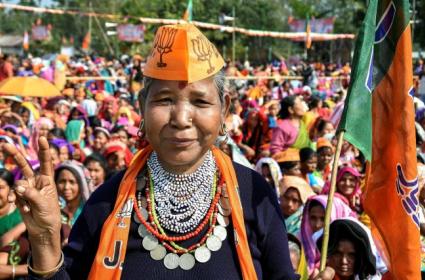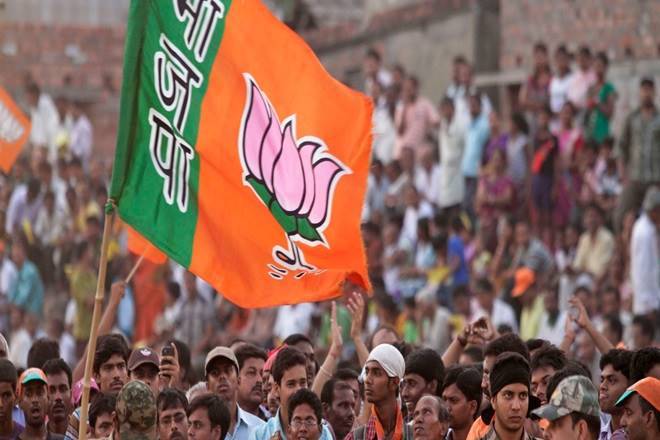Tripura - The Rise Of Saffron Tremor In The Red Bastion

The specificities of the socio-political dynamics of Tripura distinguishes it not only from other north-eastern counterparts but also from other Indian states. Politically, since the attainment of full statehood in 1972 it is the only remaining state where CPI(M) has been in power since last forty years since 1978, barring a period of five years from 1988-1992 when Congress led coalition ruled the state. Besides, the entrenchment of ideological-ethnic fault lines since late 1970s made elections as occasions replete with political violence.Moreover, it’s the first state in entire North-East that witnessed the most acute demographic change on account of the influx of Hindu Bengali refugees from Bangladesh in the aftermath of partition and 1971 war, relegating the indigenous tribal population as minority constituting around 30% of the state’s population.
CPI(M) And Tripura As A Party-Society
In the past four decades, the dominant political and electoral narrative of Tripura have been simple, that is, one is either pro-CPI(M) or anti-CPI(M) and this division permeates through all sphere of society. Shekhar Dutta, a senior journalist at Agartala, opines, ‘the domineering presence of CPI(M) in a small state like Tripura is a classic example of latters’ conversion into a ‘party-society’ wherein nothing is outside the preview of the political gaze. In this aspect, it surpassedwest-Bengal and thus even the mundane things of everyday life are deeply linked to peoples’ political affiliations and loyalties.

In fact, a series of three longitudinal fieldworks in all parts of the state by one of the author in the month of September-October 2017, January 2018 and February 2018, revealed the entrenched political divisions informing the everyday lives of the people. Hardly any village that was visited didn’t have the narrative of people being discriminated or rewarded in the matters of allotment of monthly ration, allocation of government schemes including works under MNREGAetc, based upon their political loyalties. Every village is politically divided between the ‘pro and anti’ CPI(M) camps and that got resonated in the responses of the people who share a positive or negative experiential outlook w.r.t the ruling party.
In short, CPI(M) is the savior and lifeblood to the former and a demon and devastating factor to the latter.Hence, in the recent months one witnesses the recurring instances of violent intra-tribal clashes based on their loyalties to anti-CPI(M) Indigenous Peoples Front of Tripura (IPFT) and CPI(M)’s Tripura UpajatiGanMuktiParishad (TUGMP). Similarly, the Bengali population constituting almost 70% of the population but primarily concentrated in 32% of states’ territory also share the intense political divide.

Discredited Congress And The Rise Of BJP
Since the turning of Tripura as a red-bastion since 1978 and until last assembly election of 2013, Congress undisputedly had been the fulcrum of anti-CPI(M) sections of the state. As the table-2 indicates, in the last five elections since 1993, whereupon the left front has continuously been in power, the Congress-TUJS alliance have been consistently getting the support of more than 40% of the electorates and the differences of vote percentages between the two have been in the range of 5 to 8 percent. On the other hand, in 2013 assembly election, BJP’s vote share was 1.54%. which rose to merely to 5.77% in 2014 Lok Sabha election despite the prevalence of Modi wave. The CPI(M) in fact not only won both the Lok Sabha seats but also got a whopping share of 65% of the popular votes and defeated its Congress rivals by almost a margin of five lacs. The ever-increasing winning momentum of Left front further continued after 2014Lok Sabha polls, in the elections to Panchayats (15 July 2014), the Tripura Tribal Areas Autonomous District Council (TTAADC) that covers 68% of the state territory (4 May 2015) and Nagar Panchayat & Municipal Council (2015).
However, the zenith of electoral successes of CPI(M) in the period of 2013-2015 had a profound bearing upon the political dynamics of the state as Congress lost the confidence of the vast majority of anti-CPI(M) minded voters in the state. This created a political vacuum, which in turn, created a space for a more credible alternative to anti-CPI(M).
Rise Of The BJP Since 2016
BJP in its post-2014 avatar had already set the electoral aim of having a Congress-Mukt Bharathad already set its eyes on Tripura to encircle its arch-ideological enemy, the Left, as part of its aim of realizing a Communist-Mukt Bharat. Keeping that objective in mind Sunil Deodhar, the national executive member of BJP and Prime Minister Narendra Modi's poll manager in Varanasi during the 2014 Lok Sabha election, was made the State in-charge of Tripura who immediately set upon the task of organizational overhaul. Laden by the weight of Narendra Modi led central government, BJP lost no chance in encashing the crisis of the lack of a credible opposition in the wake of discredited Congress and invested all its energy to present itself as a better alternative and determined rival to CPI(M).
Since early 2016, the success of BJP in capturing the imagination of the anti-left voters, its claim to being the dominant rival to CPI(M) and emergence as the principle opposition force was endorsedin the results of by-elections to three assembly constituencies wherein it outperformed Congress and was runner up. in the wake of fieldwork by an overarching majority of anti-left respondents, both tribal as well as Bengalis, across the state who while batting for BJP identified themselves as Congress-voters in the last assembly election, indicating a near complete shift of Congress support base to BJP. Further, to win the war of perception and increase its winnability quotient, BJP went for a multi-layered strategy of defecting the big Congress leaders to its fold as has been the case in other states; systematically highlighting the failures of the Left-front government; making economic and cultural promises having popular resonance among the people; and launching a high-profile campaign with star campaigners at the top and a team of thousands of activists, volunteers and professionals in the backdrop.
Unlike Congress, BJP mirrors CPI(M) in terms of its organizational structure and cadre base. And laden with the factor of 25 years of anti-incumbency factor against the left to its advantage, along with populist promises of 7th Pay commission to 1.5 lac government employees and the alliance with Indigenous Peoples’ Front of Tripura (IPFT) in Tribal dominated constituencies, BJP is altogether a different business in the state.’
Also, the strong trend of party ruling at the centre having a bigger sway over the electoral choice in the North-Eastern states would be a factor that CPI(M) had to grapple with while facing BJP in the first-ever direct contest between left and right in post-independent India. Irrespective of the electoral outcome, BJP has created a tremor in the last surviving red bastion.



















